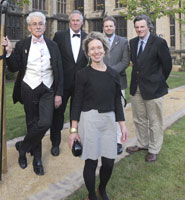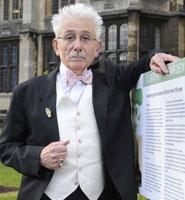Last Friday [8 May], Sir Roy Strong opened the University’s new centenary garden. Created by former Bristol student and garden designer Anne de Verteuil as part of the ongoing celebrations to mark the University’s 100th birthday this year, the garden, which is located next to the Wills Memorial Building, provides a peaceful, green retreat for the public, staff and students alike.
The garden is laid to grass, with pennant-stone paving on the Wills Tower and Park Street sides. Parallel with Park Street, a row of clear-stem, sweet gum trees gives the garden a sense of enclosure and privacy, while still allowing views between the street and garden. Large, clipped cubes of yew and hawthorn are arranged to break up the internal space and create intimate seating areas. A magnolia tree, planted off-centre, will mature into a beautiful, low-branching specimen with spring flowers.
Speaking about her inspiration for the design, Anne de Verteuil said:
‘When you’re working with a building that has a character as strong as the Wills Tower you have to think very hard about how you reflect it back. I chose to extract one element of the architecture – its strength and monumentality – as a basis for the design. It’s a very simple scheme that uses local stone and native hedging as its main components.
‘I’ve used clean lines and blocks, not just because they have a contemporary edge, but because they allow good circulation around the garden and, at the same time create smaller, more intimate spaces within it.’Her work was supported by Timothy Mowl, Professor of History of Architecture and Designed Landscapes; Alan Stealey, Gardens and Grounds Manager; and Nicholas Wray, Curator of the University’s Botanic Garden.
Stone-cutters Sarah Stewart-Smith and Peter Martin, who work near Redruth in Cornwall, inscribed the Cornish slate tablet, which records the laying out of the centenary garden. The green-oak benches were made by Martin Nichols, a craftsman based in Radstock near Bath. The benches and the lighting for the garden were kindly provided by the University's Alumni Fund.

